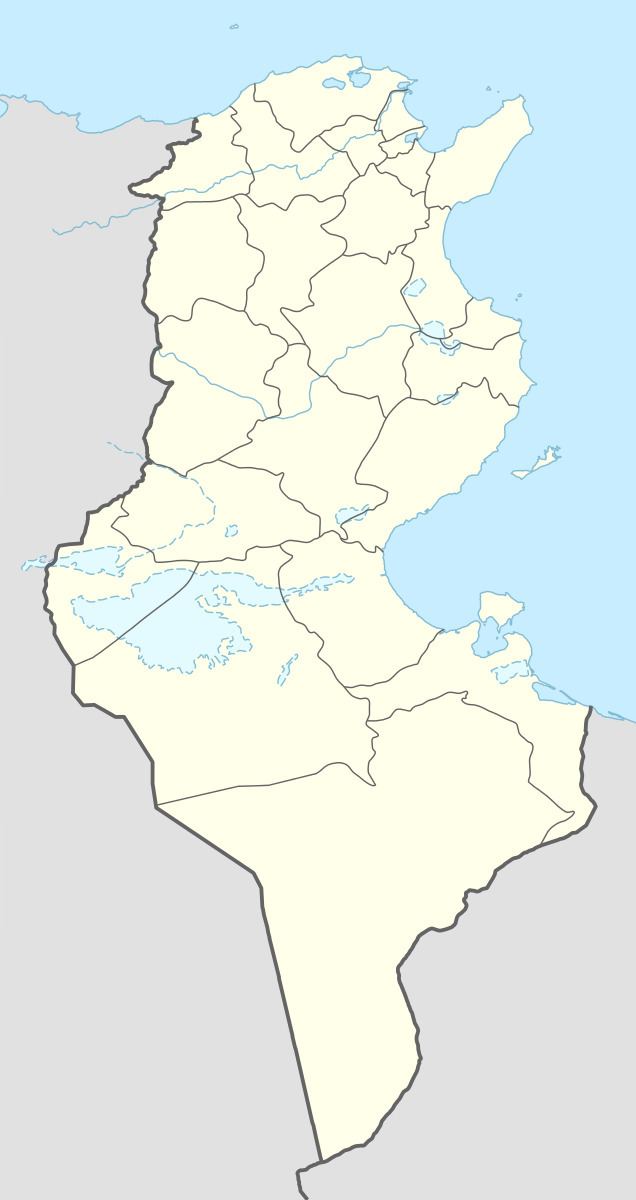Elevation 469 ft (143 m) Area 12.65 km² Local time Thursday 2:38 AM | Time zone CET (UTC1) Population 97,225 (2014) Team CS M'saken | |
 | ||
Weather 13°C, Wind N at 29 km/h, 66% Humidity | ||
M'saken (Arabic: مساكن Msākan; also spelled Masakin, Msaken) is a town in north-eastern Tunisia, close to Sousse.
Contents
- Map of Masakin Tunisia
- Etymology
- Administration
- Villages
- Personalities from Msaken
- History
- Soufism
- Statistics
- Neighboring Cities and Villages
- Migrations
- Y chromosome DNA Analysis
- Family names covered by the Y Chromosome DNA Analysis
- Family Names not Yet Covered by Y DNA Y Chromosome DNA Analysis
- Mitochondria DNA Analysis
- Twin cities
- Wikipedia Related Links
- References
Map of Masakin, Tunisia
Etymology
The origin of the word comes from "Msaken" masken (plural masken) meaning "habitat", "house" or "dwelling". This refers to "Houses of honorable people" (Masken el achraf) due to the distinguished lineage of its first inhabitants.
Administration
The town is the administrative center of a "delegation" (district) of the same name, which at the 2014 Census had a population of 97,225.
Villages
The following villages are part of Msaken delegation
Personalities from Msaken
Habib Chatti or Habib Chatty, born August 9, 1916 at M'saken and died March 6, 1991 in Paris, was a Tunisian diplomat and politician. After completing his primary education in his hometown, he continued his studies at Sadiki College in Tunis. In the late 1930s he worked in the press as editor of the newspaper Assabah. In 1955, he was appointed as Director of Information in the Government of Tahar Ben Ammar. Ambassador of Tunisia in 1958, he became Chief of Staff of President Habib Bourguiba in 1972, then Minister of Foreign Affairs from 14 January 1974 to 24 December 1977. In 1979, he was elected Secretary General of the Organization of the Islamic Conference, whose headquarters is located in Jeddah, Saudi Arabia.
History
According to local tradition, Msaken was founded by a group of descendants of Husayn Ibn Ali, son of Ali ibn Abi Talib (the prophet Muhammad's cousin) and his wife Fatima Ez-zahra (the prophet Muhammed's daughter). They had come to North Africa escaping from the Abbassid rulers of Baghdad, who had been engaged in a cruel fight against Sharifians (descendants of Husayn and his brother Hassan).
They founded a Sharifian Emirate in near present-day Tiaret in west-central Algeria. After three generations, following the fall of this Emirate, some of their descendants lived in eastern Morocco near Oujda for some time, before moving to Kairouan in Tunisia. After some decades, they founded the town of Msaken at the time of the Hafsid dynasty which was based in Tunis.
Their town was originally called 'Kousour al Ashraf' (which means "Sharif's houses"), then 'Masakin al Ashraf' (which has the same meaning), and finally Masakin - or 'Msaken' as it is pronounced and spelled in North Africa. The town centre was built around the Jamma al Awsat (which means the central mosque) and was composed of five ksars (great houses).
Soufism
Msaken is known to be a religious city. It included the Madrasa of Sidi Ali ben Khalifa and over the centuries has been home to a number of sufi figures:
Statistics
Neighboring Cities and Villages
Migrations
Msaken has a large population living in foreign countries, mainly in France and more particularly in the Côte d'Azur region, in Nice and neighbouring areas. According to some sources, 40% of the population of Msaken lives outside Tunisia. The town's population increases very significantly in July and August every year following the return of migrants to their hometown for the holidays.
Y chromosome DNA Analysis
17 people from different families in Msaken were tested for their Y chromosome DNA in 2009-2016. The tests are conducted by Kamel Gazzah and done by Family Tree DNA company. The results were as follows:
Two new SNPs have been found in five samples tested among the 13 people who belong to J2-L24 haplogroup. The rest of the group are positive for these SNPs as per their STR haplotypes matching. These SNPs are L192.2 and L271. They were first discovered in February 2010 in "Walk Through the Y" chromosome (WTY) test on a sample from Msaken belonging to the Al Gazzah family. The TMRCA is estimated to be 800 ±300 Years Before Present for SNP L271 which matches the Msaken foundation date.
The TMRCA is 3000 ±500 years for L192.2 SNP.
L192.2 SNP has a wide geographic scope: It has been found in Jordan, Turkey, Italy, Russia, Kuwait, India (Syrian Christians of Kerala), Azerbaijan, Kazakhstan, Iran, Georgia. The widest variation so far observed is in Anatolia which means that it originated there. It is particularly present among Armenians and Kurds (according to haplotypes found in the Y-chromosome haplotype database YHRD).
Family names covered by the Y Chromosome DNA Analysis
The samples belonging to J2-L271 are from the following Family Names:
Family Names not Yet Covered by Y DNA Y Chromosome DNA Analysis
List to be completed.
Mitochondria DNA Analysis
The actual Mitochondria results of people from msaken are as follows:
1- Haplogroup T2b3: probably Central/Western European origin
2 -Haplogroup T2g
3- Haplogroup N1c :Middle eastern origin (Arabia, Anatolia).
4- Haplogroup H : Eurasia.
5- Haplogroup L3f : East African roots.
6- Haplogroup L1c3 : West African roots.
7- Haplogroup K1a4a1
7- Haplogroup U4a1b
